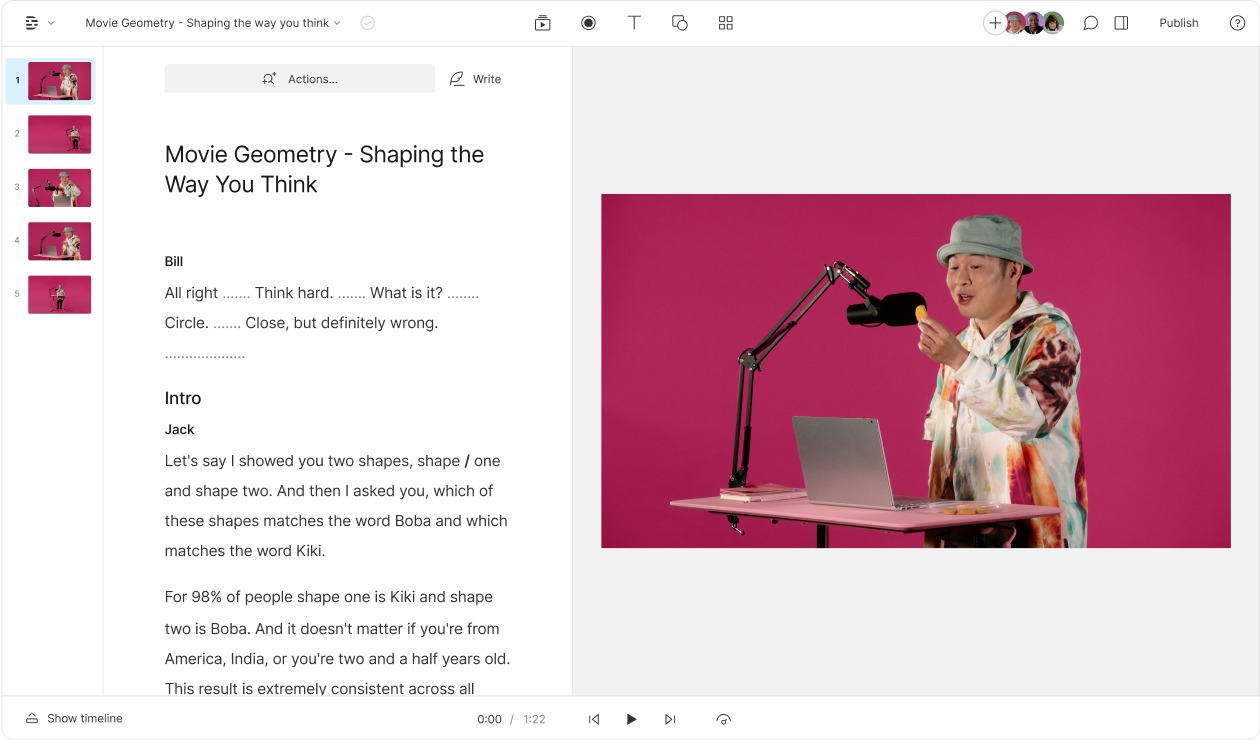What type of content do you primarily create?




Podcast discovery works in a surprisingly narrow bubble. Most listeners find new shows through podcasts they already follow, recommendations from friends, or by scrolling through familiar platforms like Spotify or Apple Podcasts. They rarely venture into unknown territory, which means your show has mere seconds to catch their ear before they move on.
A compelling podcast trailer isn't just nice to have—it's essential for turning casual browsers into actual listeners. Creating that perfect first impression takes strategy, not luck. Here's how I craft trailers in Descript that make people stop and subscribe.
Understanding the ideal trailer length
In the content gap research, there's a note that the sweet spot is typically between 30 seconds and 3 minutes for trailer length [source]. Keeping your trailer concise helps hold attention while still conveying your show’s essence. On platforms like Apple Podcasts and Spotify, shorter teasers often resonate better with listeners, who might be sampling multiple shows in a short span. Meanwhile, YouTube viewers tend to handle slightly longer trailers, around two or three minutes, especially when paced with engaging visuals. Ultimately, test different lengths to see what resonates best with your audience and track your analytics for continuous improvement.
How to write your podcast trailer logline
A podcast trailer is a short audio preview that introduces potential listeners to your show. It starts with a logline - one sentence that captures your show for a new listener. For example, here's a logline for Serial.
Serial tells one story—a true story—over the course of a season.
That accomplishes a lot with a few words: it tells you that the story is true, and that the show will follow it for the season. An effective podcast trailer logline should be concise yet informative, giving listeners just enough to pique their interest.
If the idea of writing a logline makes you freeze up, turn to Descript's Underlord for a little help. Open one of your recorded episodes in Descript, go to the sidebar, click on Underlord and ask it to write five versions of a logline for the show. The results may not be perfect, but they will get your creative wheels unstuck.

Once I have a logline, I build that out into an outline or rough script for the podcast trailer. Since most podcast trailers need to get to the point fast, they typically run from 30 seconds to 2 minutes (though some can extend to 5 minutes). To keep the structure tight, my podcast trailer scripts follow a three-part formula: A statement about what the listener can expect, a few representative sound clips, and then a call to action at the end.
Here's a sample script.
THEME MUSIC IN
VO
In every episode of Innovate & Elevate, Adam West interviews entrepreneurs with ideas that they've turned into big money. You'll learn the secrets of their success. You'll be inspired by their courage. And you'll find some of your own.
AUDIO CLIPS
“I made more money in one week than I thought I'd ever make in my life.”
“All it takes is a good idea—and persistence.”
“I'll never be able to go back to working for anyone else.”
VO
Get inspired every week on Apple Podcasts, Spotify, or wherever you get your podcasts. Want to be featured on the show? Ping us on Instagram at @innovateelevate.
THEME MUSIC OUT
If you're wondering how to choose the best audio clips for the middle part of your podcast trailer, look no further than Underlord. Go to the sidebar in Descript, click Underlord, head to the Repurpose menu, and click Create clips or Find highlights. You can also ask Underlord to Create highlight reel to automatically identify compelling moments. With AI, it's all about the prompts, so play around with different prompts until you get the engaging trailer clips you want.

Making the most of trailer distribution strategies
Once your trailer is ready, it’s crucial to place it where potential listeners can easily discover it [source]. Setting your trailer as a featured episode on hosting platforms like Apple Podcasts can increase its visibility and draw in more curious listeners. Sharing your trailer on social media and embedding it on your website can further broaden your reach. Be sure to mention the show’s release schedule or upcoming episodes within the trailer for added listener engagement. By making your trailer accessible and pervasive, you’ll give new audiences plenty of chances to discover and subscribe to your show.
Choose the perfect voice for your podcast trailer
All podcast trailers have a voice: an identifying audio signature that listeners can recognize. You want listeners to identify with and like your host, so it makes sense to make them the narrator. When I'm sketching out a trailer in Descript, I'll drop in my host's best takes as a narrative anchor, and then arrange the audio clips and music around the host's voiceover. If I don't have the host's audio yet, I record my own takes right into Descript, or use one of Descript's stock AI voices. If I'm in the early production of a show, with no episodes recorded yet, I use the host as a narrator all the way through.
Another variation for your podcast trailer is to use one of your provocative audio clips as a 'cold open.' Many interview-driven podcasts start this way. No music, no introduction, just an audio clip that grabs your attention immediately and hooks potential listeners.
For example, say you're producing a true crime show that takes place in commercial kitchens. Your trailer might start with this from a sous-chef setting the scene for the listener: “It was two in the morning. I forgot something and had to go back to the kitchen. As soon as I went in, I knew something was wrong. The lights were left on. The refrigerator was hanging open. Chef's knives were on the counter and I knew the skipper never left them behind when he left for the night. Then I heard the sirens.”
When my creative impulses are flowing in Descript, I'll move elements around, add or take away sound effects and music, and massage the message until the podcast trailer edit sounds right. High-quality audio is non-negotiable for a compelling trailer, so take time to ensure clear voice recordings, balanced sound levels, and appropriate use of music.
Always end your podcast trailer with a clear call to action. This can be as simple as 'listen wherever you get your podcasts,' or it can be more specific, such as, 'For a blast of pure inspiration and money wisdom every week, listen to Innovate & Elevate and start to thrive.' Remember that your trailer serves as an advertisement for your podcast, so make sure listeners know exactly what to do next.
You may want to make podcast trailer variations: A trailer that captures your premiere, a trailer for the mid-season, and a wrap-party trailer that celebrates a successful season of episodes. Once your trailer is complete, set it as the first episode of your show so it appears at the top of your episode list, making it easy for potential listeners to find.
FAQs
What is the ideal length for a podcast trailer?
Podcast trailers generally run 30 seconds to 3 minutes [source]. This timeframe gives you enough space to hook listeners and share your show’s unique angle without overstaying your welcome. Some platforms even favor ultra-short teasers, so don’t be afraid to experiment. So keep things as succinct as possible and always test different lengths to gauge audience interest.
How often should I update my podcast trailer?
It’s generally recommended to update your trailer whenever your show undergoes major changes, such as a new host or revised format [source]. You can also release seasonal or periodic updates to reflect your current content and keep the trailer feeling fresh. Frequent updates ensure potential listeners always get an accurate preview of what your show offers.
What tools can I use to improve my podcast trailer production?
Tools like Descript can automate transcription, manage multi-track editing, and streamline collaboration. This makes it easier to produce a polished and compelling trailer, even if you’re new to audio editing. By integrating powerful AI features, these tools also let you experiment with different audio elements to find the perfect fit for your show.





























%201.svg)









